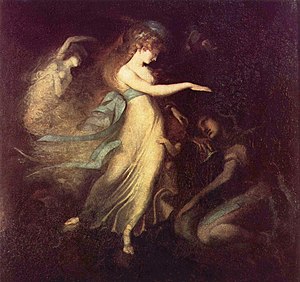Кралицата на феите
| Кралицата на феите | |
| The Faerie Queene | |
 | |
| Автор | Едмънд Спенсър |
|---|---|
| Първо издание | 1590 г. |
| Оригинален език | английски |
| Жанр | епична поема |
| Кралицата на феите в Общомедия | |
Кралицата на феите (на английски: The Faerie Queene) е незавършена английска епична поема от Едмънд Спенсър. Първата ѝ половина е публикувана през 1590 г., а втората част през 1596 г. Кралицата на феите е забележителна със своята форма: тя е първата творба, написана в спенсърова строфа и е най-дългата поема на английски език. Тя е алегорична творба, написана във възхвала на кралица Елизабет I. В голяма степен символична, поемата следва няколко рицари в разглеждане на няколко добродетели. Творбата е известна с изкуствено архаичния си език.
Кралицата на феите получава политическото благоволение на Елизабет I и вследствие на това е успех до такава степен, че става определящата творба на Спенсър. Мярка за благоволението на кралицата е пенсията, която Спенсър получава поради творбата си, в размер на £50 годишно. Творбата е широко акламирана от критиците и е предмет на множество анализи.
Епосът представлява следните добродетели:
- Книга I: Святост
- Книга II: Умереност
- Книга III: Целомъдрие
- Книга IV: Приятелство
- Книга V: Справедливост
- Книга VI: Учтивост
В допълнение към тези 6 добродетели, в писмо до Уолтър Рали, Спенсър споменава, че Артур представлява добродетелта Величие, която („според Аристотел и останалите“) е „съвършенството на всички останали и съдържа в себе си всичките тях“, а самата Кралица на феите представлява Слава (оттук името Глориана). Недовършената седма книга (Канто на променливостта изглежда е представлявала добродетелта „Постоянство“.

Библиография
[редактиране | редактиране на кода]- Abrams, M. H. (ed) (2000). Norton Anthology of English Literature (7th). New York: Norton
- Black, Joseph (ed) (2007). The Broadview Anthology of British Literature, A (concise). Broadview Press, ISBN 978-1-55111-868-0
- Cañadas, Ivan (2007). The Faerie Queene, II.i–ii: Amavia, Medina, and the Myth of Lucretia. – Medieval and Early Modern English Studies, 15(2), 383–394, doi:10.17054/memes.2007.15.2.383, архив на оригинала от 4 март 2016, http://hompi.sogang.ac.kr/anthony/mesak/mes152/Canadas.pdf, посетен на 15 март 2016
- Craig, Joanne (1972). The Image of Mortality: Myth and History in the Faerie Queene. – ELH, 39(4), 520–544, doi:10.2307/2872698, JSTOR 2872698, http://jstor.org/stable/2872698
- Cumming, William Paterson (1937). The Grammar of Spenser's Faerie Queene by Herbert W. Sugden. – South Atlantic Bulletin, 3(1), 6, doi:10.2307/3197672, JSTOR 3197672, http://jstor.org/stable/3197672
- Davis, Walter (2002). Spenser and the History of Allegory. – English Literary Renaissance, 32(1), 152–167, doi:10.1111/1475-6757.00006
- Draper, John W. (1932). Classical Coinage in the Faerie Queene. – PMLA, 47(1), 97–108, doi:10.2307/458021, JSTOR 458021, http://jstor.org/stable/458021
- Glazier, Lyle (1950). The Struggle between Good and Evil in the First Book of The Faerie Queene. – College English, 11(7), 382–387, doi:10.2307/586023, JSTOR 586023, http://jstor.org/stable/586023
- Gottfried, Rudolf B. (1968). Our New Poet: Archetypal Criticism and The Faerie Queene. – PMLA, 83(5), 1362–1377, doi:10.2307/1261309, JSTOR 1261309, http://jstor.org/stable/1261309
- Green, Paul D. (1974). Spenser and the Masses: Social Commentary in The Faerie Queene. – Journal of the History of Ideas, 35(3), 389–406, doi:10.2307/2708790, JSTOR 2708790, http://jstor.org/stable/2708790
- Greenblatt, Stephen (ed) (2012). The Norton Anthology of English Literature (9th). London: Norton, p. 775
- Greenblatt, Stephen (ed) (2006). The Norton Anthology of English Literature (8th). New York: Norton, pp. 663–687
- Geoffrey of Monmouth. Book VII Chapter III: The Prophecy of Merlin. Historia Regum Brittaniae. Caerleon Net, http://www.caerleon.net/history/geoffrey/prophecy1.htm
- Heale, Elizabeth (1999). The Faerie Queene: A Reader's Guide. Cambridge: Cambridge UP, pp. 8–11
- Healy, Thomas (2009). Elizabeth I at Tilbury and Popular Culture. Literature and Popular Culture in Early Modern England. London: Ashgate, pp. 166–177
- Levin, Richard A. (1991). The Legende of the Redcrosse Knight and Una, or of the Love of a Good Woman. – SEL: Studies in English Literature 1500–1900, 31(1), 1–24, doi:10.2307/450441, JSTOR 450441, http://jstor.org/stable/450441
- Loewenstein, David; Mueller, Janel M (2003). The Cambridge history of early modern English Literature. Cambridge University Press, ISBN 0-521-63156-4
- Marotti, Arthur F. (1965). Animal Symbolism in the Faerie Queene: Tradition and the Poetic Context. – SEL: Studies in English Literature 1500–1900, 5(1), 69–86, doi:10.2307/449571, JSTOR 449571, http://jstor.org/stable/449571
- McCabe, Richard A. (2010). The Oxford Handbook of Edmund Spenser. Oxford: Oxford UP, pp. 48–273
- McElderry, Bruce Robert Jr (March 1932). Archaism and Innovation in Spenser's Poetic Diction. – PMLA, 47(1), 144–170, doi:10.2307/458025, JSTOR 458025, http://jstor.org/stable/458025
- Micros, Marianne (2008). Robber Bridegrooms and Devoured Brides. Oral Traditions and Gender in Early Modern Literary Texts. London: Ashgate
- Millican, Charles Bowie (1932). Spenser and the Table Round. New York: Octagon
- Parker, Roscoe (1925). Spenser's Language and the Pastoral Tradition. – Language, 1(3). Linguistic Society of America, 80–87, doi:10.2307/409365, JSTOR 409365, http://jstor.org/stable/409365
- Pope, Emma Field (1926). Renaissance Criticism and the Diction of the Faerie Queene. – PMLA, 41(3), 575–580, doi:10.2307/457619, JSTOR 457619, http://jstor.org/stable/457619
- Spenser, Edmund (1984). Editorial Apparatus. The Faerie Queene. Penguin Books, ISBN 0-14-042207-2
- Spenser, Edmund (1984), Roche, Thomas P. Jr (ed). The Fairy Queene. New York: Penguin, pp. 15–18
- Turnage, Maxine. Samuel Johnson's Criticism of the Works of Edmund Spenser // SEL: Studies in English Literature 1500–1900 10 (3). 1970. DOI:10.2307/449795. с. 557–567.
- Tuve, Rosemond (1966). Allegorical Imagery: Some Medieval Books and Their Posterity. Princeton: Princeton UP
- Wadoski, Andrew (2022). Spenser's Ethics: Empire, Mutability, and Moral Philosophy in Early Modernity. Manchester University Press, ISBN 978-1-5261-6543-5
- Whitaker, Virgil K. (1952). The Theological Structure of the Faerie Queene, Book I. – ELH, 19(3), 151–155, doi:10.2307/2871935, JSTOR 2871935, http://jstor.org/stable/2871935
- Yamashita, Hiroshi; Suzuki, Toshiyuki (1993). A Textual Companion to The Faerie Qveene 1590. Kenyusha, Tokyo, ISBN 4-905888-05-0
- Yamashita, Hiroshi; Suzuki, Toshiyuki (1990). A Comprehensive Concordance to The Faerie Qveene 1590. Kenyusha, Tokyo, ISBN 4-905888-03-4
Външни връзки
[редактиране | редактиране на кода]- Online edition of The Faerie Queene
- Mary Macleod's 1916 retelling in prose
- Project Gutenberg edition of Books I-III Архив на оригинала от 2004-11-24 в Wayback Machine. incorporating modern rendition and glossary
